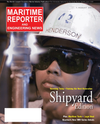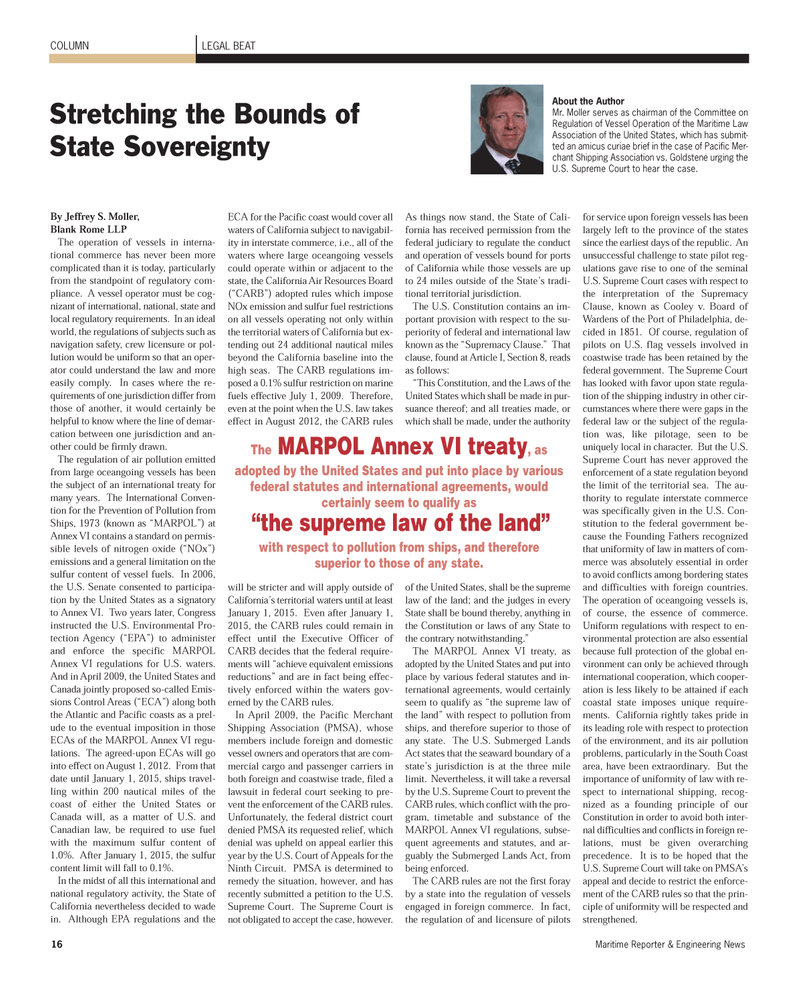
Page 16: of Maritime Reporter Magazine (August 2011)
Top 20 Shipyards of the World
Read this page in Pdf, Flash or Html5 edition of August 2011 Maritime Reporter Magazine
16Maritime Reporter & Engineering News LEGAL BEAT COLUMNStretching the Bounds of State Sovereignty By Jeffrey S. Moller, Blank Rome LLPThe operation of vessels in interna- tional commerce has never been more complicated than it is today, particularly from the standpoint of regulatory com- pliance. A vessel operator must be cog- nizant of international, national, state andlocal regulatory requirements. In an ideal world, the regulations of subjects such as navigation safety, crew licensure or pol- lution would be uniform so that an oper- ator could understand the law and more easily comply. In cases where the re- quirements of one jurisdiction differ from those of another, it would certainly be helpful to know where the line of demar- cation between one jurisdiction and an-other could be firmly drawn. The regulation of air pollution emitted from large oceangoing vessels has been the subject of an international treaty formany years. The International Conven- tion for the Prevention of Pollution from Ships, 1973 (known as ?MARPOL?) at Annex VI contains a standard on permis- sible levels of nitrogen oxide (?NOx?) emissions and a general limitation on thesulfur content of vessel fuels. In 2006, the U.S. Senate consented to participa- tion by the United States as a signatoryto Annex VI. Two years later, Congress instructed the U.S. Environmental Pro- tection Agency (?EPA?) to administer and enforce the specific MARPOL Annex VI regulations for U.S. waters. And in April 2009, the United States and Canada jointly proposed so-called Emis-sions Control Areas (?ECA?) along both the Atlantic and Pacific coasts as a prel- ude to the eventual imposition in those ECAs of the MARPOL Annex VI regu- lations. The agreed-upon ECAs will go into effect on August 1, 2012. From that date until January 1, 2015, ships travel- ling within 200 nautical miles of thecoast of either the United States orCanada will, as a matter of U.S. andCanadian law, be required to use fuel with the maximum sulfur content of1.0%. After January 1, 2015, the sulfur content limit will fall to 0.1%. In the midst of all this international andnational regulatory activity, the State of California nevertheless decided to wade in. Although EPA regulations and the ECA for the Pacific coast would cover all waters of California subject to navigabil- ity in interstate commerce, i.e., all of thewaters where large oceangoing vessels could operate within or adjacent to thestate, the California Air Resources Board (?CARB?) adopted rules which imposeNOx emission and sulfur fuel restrictionson all vessels operating not only within the territorial waters of California but ex- tending out 24 additional nautical milesbeyond the California baseline into the high seas. The CARB regulations im- posed a 0.1% sulfur restriction on marinefuels effective July 1, 2009. Therefore, even at the point when the U.S. law takes effect in August 2012, the CARB rules will be stricter and will apply outside ofCalifornia?s territorial waters until at least January 1, 2015. Even after January 1, 2015, the CARB rules could remain ineffect until the Executive Officer of CARB decides that the federal require-ments will ?achieve equivalent emissions reductions? and are in fact being effec- tively enforced within the waters gov- erned by the CARB rules.In April 2009, the Pacific Merchant Shipping Association (PMSA), whose members include foreign and domesticvessel owners and operators that are com- mercial cargo and passenger carriers in both foreign and coastwise trade, filed a lawsuit in federal court seeking to pre- vent the enforcement of the CARB rules. Unfortunately, the federal district court denied PMSA its requested relief, whichdenial was upheld on appeal earlier this year by the U.S. Court of Appeals for the Ninth Circuit. PMSA is determined toremedy the situation, however, and has recently submitted a petition to the U.S.Supreme Court. The Supreme Court is not obligated to accept the case, however. As things now stand, the State of Cali- fornia has received permission from the federal judiciary to regulate the conduct and operation of vessels bound for ports of California while those vessels are up to 24 miles outside of the State?s tradi- tional territorial jurisdiction. The U.S. Constitution contains an im-portant provision with respect to the su- periority of federal and international law known as the ?Supremacy Clause.? That clause, found at Article I, Section 8, reads as follows: ?This Constitution, and the Laws of the United States which shall be made in pur- suance thereof; and all treaties made, orwhich shall be made, under the authorityof the United States, shall be the supremelaw of the land; and the judges in every State shall be bound thereby, anything in the Constitution or laws of any State to the contrary notwithstanding.? The MARPOL Annex VI treaty, as adopted by the United States and put intoplace by various federal statutes and in- ternational agreements, would certainly seem to qualify as ?the supreme law of the land? with respect to pollution fromships, and therefore superior to those ofany state. The U.S. Submerged Lands Act states that the seaward boundary of a state?s jurisdiction is at the three mile limit. Nevertheless, it will take a reversal by the U.S. Supreme Court to prevent the CARB rules, which conflict with the pro-gram, timetable and substance of theMARPOL Annex VI regulations, subse- quent agreements and statutes, and ar- guably the Submerged Lands Act, from being enforced. The CARB rules are not the first foray by a state into the regulation of vessels engaged in foreign commerce. In fact, the regulation of and licensure of pilots for service upon foreign vessels has been largely left to the province of the states since the earliest days of the republic. An unsuccessful challenge to state pilot reg- ulations gave rise to one of the seminal U.S. Supreme Court cases with respect tothe interpretation of the Supremacy Clause, known as Cooley v. Board of Wardens of the Port of Philadelphia, de- cided in 1851. Of course, regulation of pilots on U.S. flag vessels involved in coastwise trade has been retained by thefederal government. The Supreme Court has looked with favor upon state regula- tion of the shipping industry in other cir- cumstances where there were gaps in the federal law or the subject of the regula- tion was, like pilotage, seen to be uniquely local in character. But the U.S. Supreme Court has never approved the enforcement of a state regulation beyond the limit of the territorial sea. The au- thority to regulate interstate commerce was specifically given in the U.S. Con- stitution to the federal government be- cause the Founding Fathers recognized that uniformity of law in matters of com- merce was absolutely essential in order to avoid conflicts among bordering states and difficulties with foreign countries. The operation of oceangoing vessels is, of course, the essence of commerce.Uniform regulations with respect to en- vironmental protection are also essentialbecause full protection of the global en-vironment can only be achieved through international cooperation, which cooper- ation is less likely to be attained if each coastal state imposes unique require-ments. California rightly takes pride in its leading role with respect to protectionof the environment, and its air pollution problems, particularly in the South Coastarea, have been extraordinary. But the importance of uniformity of law with re- spect to international shipping, recog-nized as a founding principle of ourConstitution in order to avoid both inter- nal difficulties and conflicts in foreign re- lations, must be given overarching precedence. It is to be hoped that theU.S. Supreme Court will take on PMSA?s appeal and decide to restrict the enforce-ment of the CARB rules so that the prin-ciple of uniformity will be respected andstrengthened.About the AuthorMr. Moller serves as chairman of the Committee on Regulation of Vessel Operation of the Maritime Law Association of the United States, which has submit-ted an amicus curiae brief in the case of Pacific Mer-chant Shipping Association vs. Goldstene urging the U.S. Supreme Court to hear the case. TheMARPOL Annex VI treaty , asadopted by the United States and put into place by variousfederal statutes and international agreements, would certainly seem to qualify as ?the supreme law of the land? with respect to pollution from ships, and therefore superior to those of any state. MR Aug. 11 # 2 (10-17):MR Template 8/3/2011 9:48 AM Page 16

 15
15

 17
17
